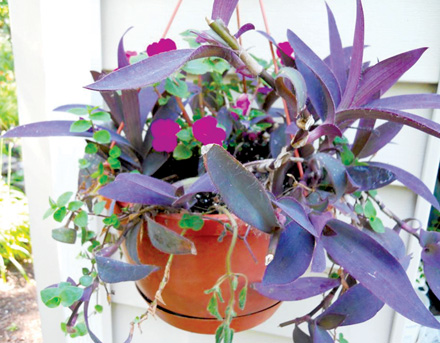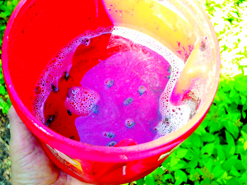Answering Emails: What’s wrong with my hanging basket?

“I bought the most amazing hanging baskets… they are now both dead. What happened?” — Lisa
Hi Lisa, it’s easy to over-fertilize plants, especially those in hanging baskets. They do grow quickly with fertilizers but once the fertilizer moves through the soil, nothing is left to sustain the plants and they die.
The hanging basket in the photo is the standard 12-inch hanging pot that gets treated with a good addition of compost before I add anything. The little limp start at the front will root in a couple of days and, with the help of rain, this little hanging basket will have a happy summer.
Growth, however, will be slow, keeping pace with the hanging basket available space. When the baskets get too full, I will trim them back and give them another compost amendment.
Actually, this hanging basket spends all year with me, wintering over inside and then getting placed outdoors for most of the growing season. I think I have had this hanging basket a good 5-6 years so keeping the soil happy is the key to successfully keeping hanging baskets alive.
When these hanging baskets get over-stimulated with too much fertilizer, especially the soluble blue kind, these baskets don’t have enough nutrients in their limited soil to sustain growth. My advice is to buy hanging baskets only with plant starts and allow them to grow into the available space.
If you want a full hanging basket, know that they got that way by growing fast. Buy it for your event, then afterwards if you want to try to salvage it, remove the plants and soil; add new soil with compost and hope the plants establish themselves in their new growing medium.
“I can’t find Japanese beetle traps anywhere, why aren’t they sold any more?” – Harold
There’s an interesting reason Japanese beetle traps are not as available as they used to be. According to a couple of friends who work in gardening retail, some homeowners complained the traps attracted more Japanese beetles than they eliminated so retailers stopped carrying them.
Japanese beetle traps are basically female Japanese beetle pheromones, attracting male Japanese beetles. If you read the directions, the traps are supposed to be located down wind at the edge of your property to attract the Japanese beetles away from your plants. Or, if you don’t like your neighbors, you can guide the bugs onto your neighbor’s property but then you have bigger problems than just Japanese beetles.
Most people, however, are placing the traps wherever, using the traps as substitutes for capturing the beetles themselves. In the long run, they are drawing the bugs into areas without infestations.
The good news is that all you need is some dishwashing soap drops, a can with a lid half full of water and a few minutes early morning to walk your garden to shake the beetles into the water-filled can to drown. This is much more effective, and less expensive, than traps.
Charlotte Ekker Wiggins is a beekeeper, gardener and sometimes cook. Published by El Dorado Springs Sun once in print and online with author’s permission. Copyright 2017, all rights reserved. This column may not be reprinted, republished or otherwise distributed without author’s permission. Contact Charlotte at gardeningcharlotte@gmail.com.

CARE FOR HANGING BASKETS – One of my long lasting hanging baskets gets fresh compost every other month. The compost helps to keep the soil alive and healthy.

GOOD JAPANESE BEETLES – Soapy water works better than Japanese beetle traps. The soapy water kills the beetles while the traps attract more beetles into the area with the female beetle pheromones. (Photos by Charlotte Ekker Wiggins).



Facebook Comments